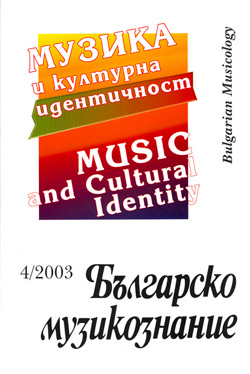Та що е то културна идентичност?
So, What Does Cultural Identity Mean?
Author(s): Lyuben BotusharovSubject(s): Music
Published by: Институт за изследване на изкуствата, Българска академия на науките
Summary/Abstract: The paper considers the devaluated today concept of identity, respectively cultural identity in relation to some errors made in its use, respectively the limits of its use. A particular attention is paid to the cultural identity of the community. Self-determination is not just placing a label, identification involves compa ring units no matter how complex they are. The identical, which concerns units of the same order, is often mixed with the peculiar, which (according to Hegel) is understood in the dialectic of the unique and the common. The interrelation between the psychic and the social allows the adoption of a mechanism of forming the identity of culture, similar to the process of identification in the individual, located (according to E.Erikson) in the character of the individual as well as in the essence of his/her community culture: a complex reflection of self-evaluation in comparison with the assessment of the others and vice versa. This by necessity mostly unconscious process with the individual, in respect to culture could be called spontaneous. The problems of revealing the cultural identity are also based on the rationalization of the concept of culture. A cyber-informational understanding of culture as management is presented, which -along with the activity model - includes the value system of describing the aim as well. Identification means the choice of the adaptation model. The management of creating <the second nature> is essential i.e. the formation of man, respectively the community, which imposes the distinction between community and society (according to F.Toennies), respectively culture and civilization. The role of music as a constructor of identity is considered: a characteristic feature of music is suggestion as a specific factor of human communication. Two examples are being commented on: I) A competition poster as interference of <Bulgarian> (= the national as homogeneous culture -according to F.Gellner) and <Americanization> as <patchwork> of identities in late modernity (= the civilizational). 2) a sound example (urban folklore) as a parody of the Gypsy (=Bulgarian) and a complex interaction between the ethnic and political identity.
Journal: Българско музикознание
- Issue Year: 2003
- Issue No: 4
- Page Range: 12-20
- Page Count: 9
- Content File-PDF

